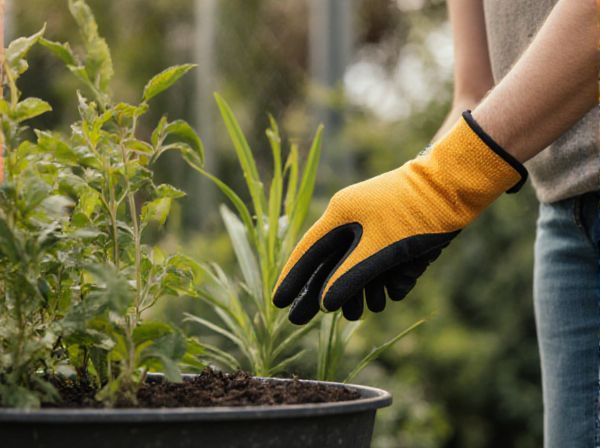
Handpicking vs trap cropping Illustration
Handpicking targets pests directly by manually removing them from plants, offering an immediate and chemical-free control method ideal for small-scale gardens. Trap cropping involves planting specific crops to attract pests away from main crops, effectively reducing pest pressure by diverting their attention and limiting damage to valuable plants. Both strategies minimize pesticide use while promoting sustainable pest management through targeted interventions.
Table of Comparison
| Aspect | Handpicking | Trap Cropping |
|---|---|---|
| Definition | Manual removal of pests from crops. | Planting specific crops to attract pests away from main crops. |
| Effectiveness | High for small infestations. | Effective for managing pest populations on a larger scale. |
| Labor Intensity | Labor-intensive and time-consuming. | Less labor-intensive after initial setup. |
| Environment Impact | Eco-friendly; no chemicals used. | Eco-friendly; supports integrated pest management. |
| Cost | Low direct cost, higher labor cost. | Moderate cost due to additional planting. |
| Suitability | Best for small gardens or low pest density. | Best for large fields with known pest preferences. |
Introduction to Handpicking and Trap Cropping
Handpicking involves manually removing pests from plants, providing an immediate and chemical-free pest control method suitable for small-scale gardens and low pest infestations. Trap cropping uses specific plants to attract pests away from the main crop, acting as a strategic barrier that reduces damage to valuable plants by concentrating pest populations on sacrificial crops. Both techniques emphasize sustainable pest management by minimizing chemical usage and promoting ecological balance in agricultural practices.
Understanding Common Garden Pests
Handpicking targets pests such as caterpillars and beetles by physically removing them from plants, offering immediate reduction without chemicals. Trap cropping uses sacrificial plants like mustard greens to lure pests away from valuable garden crops, effectively managing aphids, flea beetles, and whiteflies. Combining both methods enhances pest control in organic gardens by addressing pest behavior and population dynamics.
How Handpicking Works in Pest Management
Handpicking involves manually removing pests like caterpillars, beetles, or aphids from plants, providing an immediate reduction in pest populations without chemical use. This labor-intensive method is most effective in small-scale gardens or early infestation stages, targeting visible insects directly to prevent further crop damage. By physically eliminating pests, handpicking minimizes reliance on pesticides and supports sustainable pest management practices.
The Basics of Trap Cropping
Trap cropping involves planting a sacrificial crop that attracts pests away from the main crops, effectively reducing pest damage. Unlike handpicking, which requires manual removal of pests, trap cropping creates a pest refuge, concentrating insects on a preferred plant to minimize infestation. This technique is especially useful for managing pests like aphids, beetles, and caterpillars in vegetable gardens and organic farming systems.
Benefits of Handpicking Pests
Handpicking pests allows precise control of infestations without chemical interventions, preserving beneficial insects and promoting organic farming practices. This method reduces pesticide resistance risks and minimizes environmental contamination while directly removing pests from plants, ensuring immediate damage mitigation. Targeting specific pests like beetles and caterpillars enhances crop health and increases yield quality through sustainable pest management.
Advantages of Trap Cropping Strategies
Trap cropping strategies effectively reduce pest populations by attracting insects away from main crops, minimizing chemical pesticide use and promoting sustainable agriculture. This targeted approach enhances biodiversity and supports natural pest predators, improving overall crop health. Implementing trap crops also lowers crop damage and increases yield quality by creating a protective pest barrier.
Limitations of Handpicking Methods
Handpicking pests is labor-intensive and often impractical for large-scale crop production due to the time and effort required to manually remove insects. This method is also less effective against fast-reproducing or cryptic pests that hide within plant foliage or soil, diminishing control efficiency. Inconsistent pest removal can lead to reinfestation, reducing overall pest management success compared to trap cropping strategies that attract and concentrate pests away from main crops.
Challenges Faced with Trap Cropping
Trap cropping often faces challenges such as the selection of appropriate trap plants that effectively attract pests away from the main crop, which can be inconsistent across different pest species. Managing trap crops requires extra labor and monitoring to prevent them from becoming breeding grounds for pests, potentially exacerbating infestations. Environmental factors like weather and landscape complexity further impact the success of trap cropping by influencing pest movement and survival.
Comparing Effectiveness: Handpicking vs Trap Cropping
Handpicking targets individual pests by physically removing them, providing immediate control but requiring significant labor and constant monitoring. Trap cropping uses specific plants to attract pests away from main crops, reducing pest damage on primary plants and decreasing pesticide use. Effectiveness depends on pest density, crop type, and resource availability, with trap cropping offering more sustainable control in larger-scale farming.
Choosing the Right Pest Control Method for Your Garden
Handpicking pests manually offers precise removal of insects like caterpillars and beetles, ideal for small gardens or low infestation levels. Trap cropping involves planting sacrificial crops to lure pests away from main plants, reducing damage and minimizing chemical use. Selecting between handpicking and trap cropping depends on garden size, pest type, and infestation severity to optimize pest control efficacy.
Handpicking vs trap cropping Infographic

 gardendif.com
gardendif.com